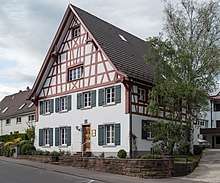Allensbach Institute
The Allensbach Institute, formally the Allensbach Institute for Public Opinion Research or Allensbach Institute for Public Opinion Polling (German: Institut für Demoskopie Allensbach), is a private conservative[1][2][3] opinion polling institute based in Allensbach, Baden-Württemberg, Germany.
 | |
| GmbH | |
| Industry | Public opinion research |
| Genre | Opinion polling |
| Founded | 1947 |
| Founder | Elisabeth Noelle-Neumann Erich Peter Neumann |
| Headquarters | , |
Key people | Elisabeth Noelle-Neumann Renate Köcher |
| Revenue | €8,500,000 (2005) |
Number of employees | 100 |
| Website | www.ifd-allensbach.de/ |

History
Founded in 1947 by political scientist Elisabeth Noelle-Neumann and journalist[4] Erich Peter Neumann, and modelled after Paul Lazarsfeld's Wirtschaftspsychologische Forschungsstelle at the University of Vienna,[5] the Allensbach Institute was the first public opinion research institute in Germany,[6] depending primarily on the sale of market research studies for financing.[7] The institute conducted the "first [post-war] inquiry to assess former Nazi support",[8] and was contracted by the government of the Federal Republic of Germany in 1950 to carry out monthly surveys of domestic public opinion.[5]
In 1988, political economist Renate Köcher, a former advisor to Chancellor Helmut Kohl, became managing director of the institute alongside Noelle-Neumann,[6] who was also the sole shareholder in the company. Noelle-Neumann transferred ownership of the institute to the Allensbach Foundation for Public Opinion Research (German: Stiftung Demoskopie Allensbach) in May 1996.[5]
The Allensbach Institute is noted for providing the most accurate prediction of the results of the closely contested 1998 German federal election.[6][9][10][11]
Activities
The Allensbach Institute conducts market, media and social research, as well as political opinion research,[5] and has performed polls on topics ranging from participation in sports[12] to "radio listening and newspaper reading habits"[13] to support for a European monetary union and economic and monetary union.[14] Deborah Ascher Barnstone, in a study of transparency in politics and architecture in Germany, asserted that the range of subjects covered by the Allensbach Institute makes it "an excellent source for information on the [German] general populace".[15]
The institute is known for its annual New Year survey of the "state of the German soul" as commentator David Marsh, citing some 2012 and comparative results, termed it.[16]
The institute employs roughly one hundred full-time employees, including about 25 scientists, and two thousand avocational interviewers, and conducts approximately one hundred surveys and 80,000 interviews yearly. Although the institute conducts surveys primarily of German public opinion, it has participated in or carried out multiple "international opinion research projects".[5]
See also
- European Society for Opinion and Marketing Research
References
- Kelly, Suzanne (September 1998). "East-West divide lives on in German politics". CNN. Archived from the original on 2008-01-21. Retrieved 2008-02-07.
-
Vinocur, John (2002-09-19). "Electorate appears to forgive him the policy contradictions : Schroeder charms away the doubts". International Herald Tribune. Archived from the original on 2011-06-04. Retrieved 2008-02-07.
... the Allensbach Institute, which has long-time connections with conservative politics...
-
Schwarz, Peter (2000-01-06). "The crisis of the German Social Democratic Party". World Socialist Web Site. Retrieved 2008-02-07.
The Allensbach Institute ... is notorious for its proximity to the CDU...
- Noelle-Neumann, Elisabeth (1980). "The Public Opinion Research Correspondent". Public Opinion Quarterly. 44 (4): 585–97. doi:10.1086/268626. JSTOR 2748475.
- Buckow, Anjana (2001). "Allensbach Institute". In Bernard A. Cook (ed.). Europe Since 1945: An Encyclopedia. New York: Garland Publishing. p. 32. ISBN 978-0-8153-4057-7. Retrieved 2008-02-04.
- "Das Institut für Demoskopie Allensbach". Hamburger Abendblatt. 2007-04-30. Retrieved 2008-02-04.
- Katona, George (1953). "Survey Research in Germany". Public Opinion Quarterly. 17 (4): 471–80. doi:10.1086/266476. JSTOR 2746038.
-
Johnson, Eric A.; Karl-Heinz Reuband (2005). What We Knew: Terror, Mass Murder, and Everyday Life in Nazi Germany. Basic Books. pp. 327. ISBN 978-0-465-08572-9. Retrieved 2008-02-04.
Allensbach Institute.
- James, Peter (February 2000). "The 1998 German Federal Election". Politics. 20 (1): 33–38. doi:10.1111/1467-9256.00108.
- Erlanger, Steven (2002-09-14). "2 Germans Tinge the Political Debate With Personal Attacks". The New York Times. Retrieved 2008-02-07.
- Erlanger, Steven (2002-09-22). "Germans Vote in a Tight Election in Which Bush, Hitler and Israel Became Key Issues". The New York Times. Retrieved 2008-02-07.
- Pfister, Gertrud (2002). "Sport for women". In Roland Naul; Ken Hardman (eds.). Sport and Physical Education in Germany. International Society for Comparative Physical Education and Sport Series. Routledge. pp. 165–90. ISBN 978-0-419-25390-7. Retrieved 2008-02-06.
- Horkheimer, Max (1952). Survey of the Social Sciences in Western Germany. Washington, D.C.: Library of Congress. p. 81. Retrieved 2008-02-06.
- Le Gloannec, Anne-Marie (1992). "The Implications of German Unification for Western Europe". In Paul B. Stares (ed.). The New Germany and the New Europe. Washington, D.C.: Brookings Institution Press. pp. 251–78. ISBN 978-0-8157-8137-0. Retrieved 2008-02-06.
-
Barnstone, Deborah Ascher (2005). The Transparent State: Architecture and politics in postwar Germany. Routledge. p. 212. ISBN 978-0-415-70019-1. Retrieved 2008-02-06.
For each study, the institute questions thousands of Germans on every subject imaginable from history to politics to women's issues to immigration policy. It is, therefore, an excellent source for information on the general populace.
-
Marsh, David (2012-02-13). "Why does Germany feel so good about itself?". MarketWatch. Retrieved 2012-02-13.
Despite all the uncertainties about the debt crisis [in early 2012], 49% of the populace were hopeful about the next 12 months, only 17% said they were worried, although 26% said they were “skeptical.” The proportion in the optimism category was a bit lower than 56% the previous year, but this is still a relatively high figure. Since German was reunified in 1990, there have been only eight years when a majority said they were hopeful. And only three years since the turn of the century (2000, 2007 and 2010).
External links
- Official website
- Statista (Publication and Analysis of Allensbach Institute surveys)